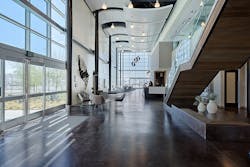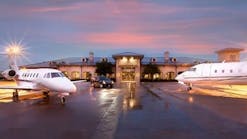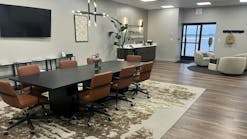When Landmark Aviation began planning for its new FBO facility at San Diego International Airport (SAN), it looked to the main airport’s modernization project for guidance
"Landmark wanted to work in conjunction with the airport’s commitment to the Terminal 2 Green Build Program and apply it to the development of our 13-acre new general aviation FBO campus,” says Louis Bradberry, Landmark Aviation’s construction manager. The Green Build initiative requires all new airport projects to attain at least a LEED-Silver rating, but Landmark Aviation set its sights even higher--on a Platinum rating.
The airport handles more than 500 flights a day, and its Green Build construction project brought a set of long-awaited upgrades for the traveling public. As the largest improvement project in the airport’s history, the $1 billion Green Build project helps meet the airport’s current and future demand for travel and improves customer service. Its 10 new gates reduce terminal congestion and enhanced curbside check-in speeds passengers through check in. The facility was awarded Leadership in Energy and Environmental Design (LEED) Platinum certification for the Green Build terminal expansion from the U.S. Green Building Council (USGBC), making it the first LEED Platinum-certified commercial airport terminal in the world. Landmark Aviation’s new facility is following suit; its Platinum certification is currently under LEED review by the USGBC.
Landmark Aviation operates 69 FBO facilities throughout North America and Europe. “As a company, Landmark Aviation is dedicated to making environmentally friendly business decisions. As part of that responsibility, we build to LEED specifications whenever possible, whether the project will be certified or not. In San Diego, we made a commitment to the airport to be certified LEED Platinum. LEED Platinum had never been achieved on the scale of a general aviation FBO campus, so we are proud to say that we are slated to achieve this milestone and are submitting 85 of the required 80 points for LEED Platinum,” Bradberry says.
Environmentally Friendly Facility
The $39 million facility is located at 3300 Terminal Link Rd., near the intersection of Sassafras Street and Pacific Highway; Landmark signed a 37-year lease with the San Diego County Regional Airport Authority. The FBO campus features a 19,000 square-foot terminal, a 250,000 square-foot ramp and five hangars on 12.4 acres. Its amenities include office space, a snooze room, VIP lounge, fitness center, viewing deck, gourmet café and an executive conference room.
Several companies were involved in the project including Turner Construction Company, Rivers and Christian, Tammy Edmonds Design, KPFF Consulting Engineers, Kleinfelder, NV5 Nolte Associates, Spurlock Poirier Landscape Architects, and TMAD Taylor & Gaines. Many of these companies are based in the San Diego area.
According to Turner Construction, the general contractor on the project, notable LEED features include bio-swales and permeable paved surfaces that manage water runoff and remove silt and pollution from surface runoff. The facility was constructed with low-volatile organic compound paints, sealants and building materials; urinals are all ultra-low water use models, toilets have water-saving dual-flush systems and faucets are high-efficiency models with sensors. Initial records indicate 49 percent water savings.
The building’s design takes maximum advantage of natural light and 100 percent of the building’s electricity can be produced by solar panels mounted on the roof. Lighting throughout the facility uses low-energy consuming LED lamps and other building materials are made with sustainable products.
FBO personnel and visitors can monitor energy use and solar electricity production on a kiosk located in the main reception area. The touchscreen allows users to learn more about the building’s energy-saving features.
“This project took a lot of collective effort and dedication over the last two years, and we are very impressed with the finished product,” says Dan Bucaro, Landmark Aviation president and CEO. “We are excited to offer our customers a more spacious and modern facility, boasting many amenities. We couldn’t have done this without the support of the San Diego County Regional Airport Authority.”
Sustainability and environmental sensitivity were hallmarks of the airport’s Green Build project, which was emulated in the planning, design and construction of the Landmark FBO facility. For instance, construction material waste from the project, such as concrete, was recycled and reused on site. The design also decreased water usage, reduced energy consumption and uses alternative energy sources.
“This was new construction, so we didn’t have to modify existing elements and we could design the campus with smart systems from the ground up,” says Bradberry.
While many FBOs considering new construction shy away from LEED certification, Bradberry says the additional cost wasn’t a huge factor. “There isn’t too much more of a premium cost necessarily involved in achieving LEED Platinum status. However, what drives the costs is that certain technologies such as LED lighting or certain mechanical systems have not seen the types of cost savings as conventional systems. This is largely because they don’t have the same demand, so the per-unit cost is still higher,” Bradberry says.
The USGBC cites there are significant savings to owners and the environment for facilities built with sustainability in mind. It reports that in the United States, buildings account for 38 percent of all carbon dioxide emissions, consume 13.6 percent or 15 trillion gal./year of potable water and consume 73 percent of the electricity produced in the United States.
It also reports that LEED projects are responsible for diverting more than 80 million tons of waste from landfills. The General Services Administration reports that when it compares LEED Gold buildings to conventional buildings, the LEED-Gold facilities consume 25 percent less energy and generate 34 percent less greenhouse gas emissions.
“The project’s use of renewable energy was the main feature that makes it a LEED Platinum performing project,” says Bradberry. “The team was able to leverage the large roof areas of the hangars for photovoltaic (PV) arrays, which let the project achieve almost all of the energy efficiency credits. The PV system enabled us to achieve almost 30 points that would have been more difficult and costly to achieve otherwise. In fact, I don’t think it is really possible to achieve a LEED Platinum rating without some form of renewable energy component in the mix. That’s really what sets Platinum apart from the other rating levels.”




